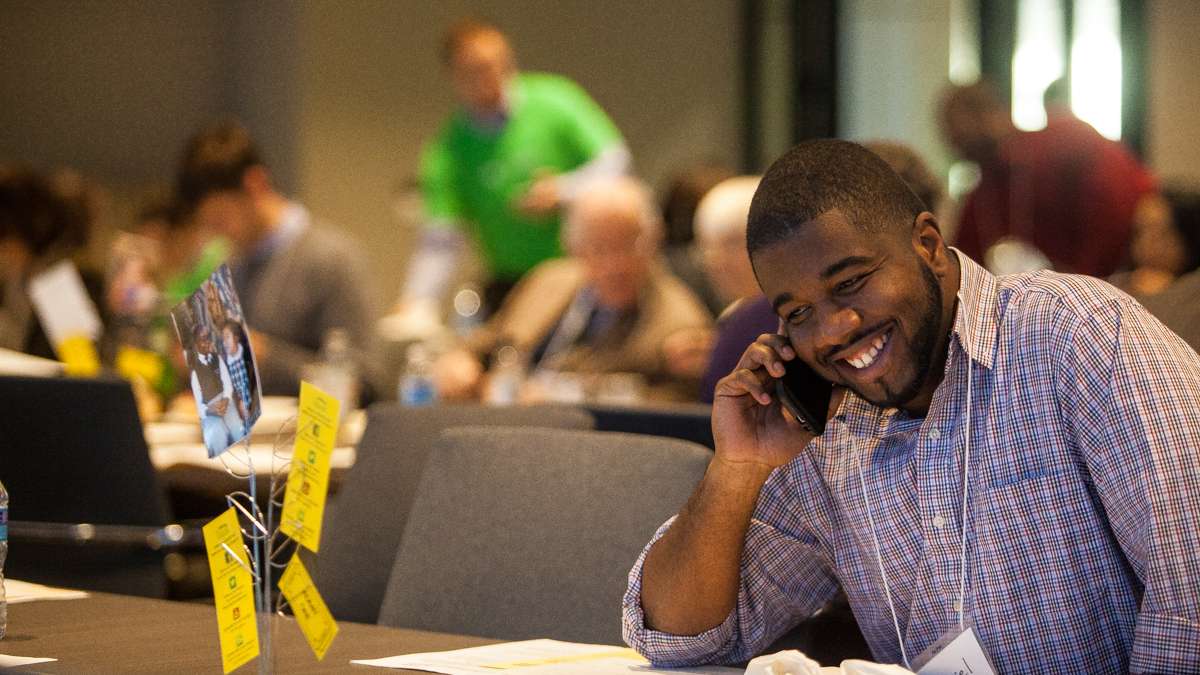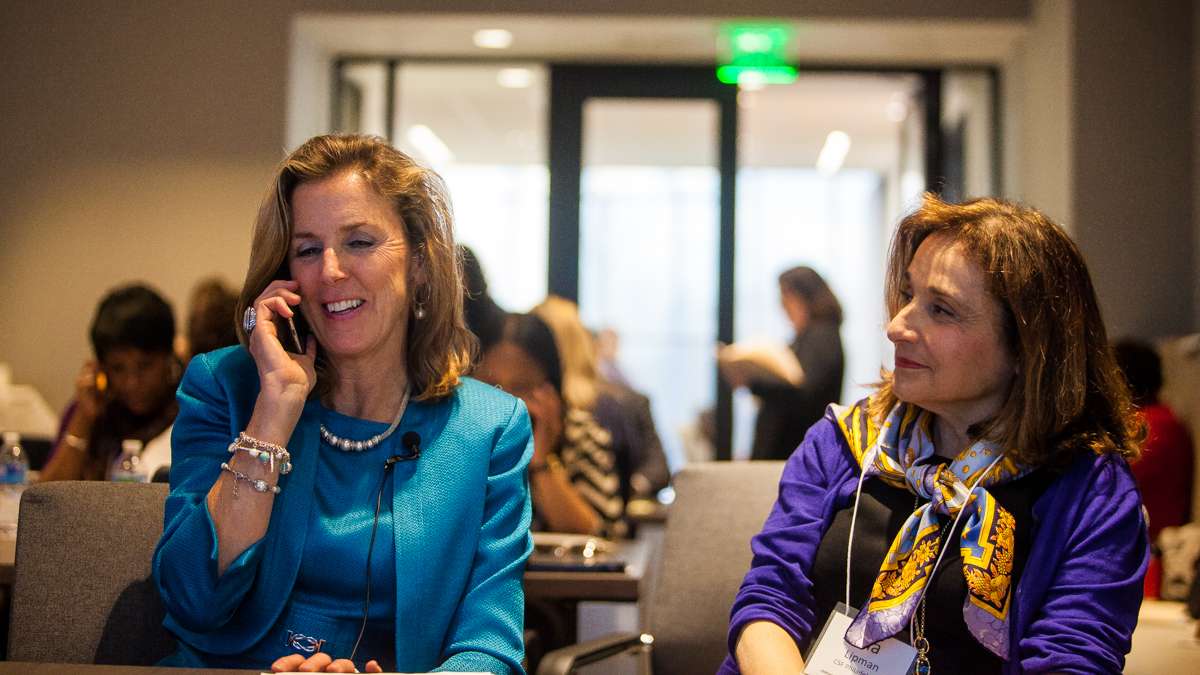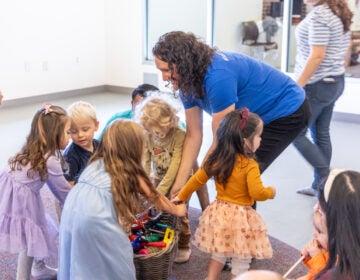Pa. scholarships funded through tax credits lift some, raise questions for others
Listen-

-

-

-

-

Katie McGinty, chief of staff to Gov. Tom Wolf, speaks with the recipient of a scholarship Thursday after calling his home. At her right is Ina Lipman, executive director of the scholarship fund. (Brad Larrison/for NewsWorks)
-

-

-

One night in March, Kristen Lewis was working her cell phone as one of about 50 volunteers for the Children’s Scholarship Fund of Philadelphia. They were calling families to let them know they had won a scholarship to take their kids out of low-performing public schools.
In between calls, she got a call from a blocked number.
“I’m like, ‘Shut the front door. Are you serious?'” said Lewis, who teared up when she got off the phone. Her own son had received a four-year scholarship.
This year, about 9,000 families applied for the organization’s K-8 scholarships. Through a lottery system, 2,000 of those families landed funds, totaling up to $2,350 annually, for private or religious schooling.
Lewis and other parents see the scholarship as more than just money. For Rashida Johnson, it provides an added measure of safety for her son, Nate.
“I feel good about his [private] school because he also has a medical condition, and sometimes he has to visit the nurse, and she calls me every time he visits,” said Johnson. “I knew that, unfortunately, he probably would not have gotten the same care at the neighborhood school because a lot of the schools don’t have full-time nurses.”
Does tax credit system help or hurt kids?
Lewis and Johnson are on the receiving end of the Opportunity Scholarship Tax Credit, a program designed to help families living in areas where the lowest-performing 15 percent of public schools draw their students.
According to Pennsylvania’s Department of Community and Economic Development, 7,601 children received OSTC scholarships in the 2013-2014 school year. Their families must make less than $75,000 a year to qualify, although the average family getting the money makes only $29,000.
OSTC is one of two Pennsylvania education tax credits that make up $150 million of the annual state budget. The other program, the Educational Improvement Tax Credit, makes up two-thirds of that pot and has fewer restrictions on who can use the money.
Businesses that donate to scholarship outfits get up to 90 percent of their donations back in the form of a tax credit from the state.
It’s this number that bothers critics such as Larry Feinberg, co-founder of the Keystone State Education Coalition. “You know, if you have kids that are starving, you don’t feed them by taking food away from their peers,” he said.
Ideas about how to help kids in these schools tend to fall into two camps: hunker down and improve the underperforming schools or give some kids the option to leave. Feinberg advocates for the first option; practically, tax credits do the second.
The timing of the new tax credit program may have contributed to the pushback. The Opportunity Scholarship Tax Credit was approved in 2012, just one year after state spending on public education fell by a billion dollars under Gov. Tom Corbett.
According to Feinberg, any money out of the state’s general budget could go to schools and help all students. And, he said, when these students leave, school quality suffers.
“Every time we take a kid that has interested, involved parents out of a school … you make it tougher and tougher for the school to be successful,” Feinberg said.
Proponents of school choice and the tax credit programs argue that kids leaving for private or religious schools don’t cost school district tuition and other fees associated with charter schools, and thus save public schools money.
Two sides of the political coin
Pennsylvania tax credit programs have been both maligned and supported in the debate around school choice. In recent months, the companies and individuals donating to earn tax credits have themselves come under scrutiny.
Some businesses have given millions of dollars, using multiple companies to put in well over the amount needed to receive the maximum tax credit of $750,000. According to the Deparment of Community and Economic Development, this is legal. Proponents of the credits argue that they’re just trying to leverage their money to help more students.
“One of the major factors in why companies participate in this program has to be motivated by altruism and mission,” according to Ina Lipman, CEO of the Children’s Scholarship Fund of Philadelphia. That’s because businesses still have less money if they donate to the program than if they just kept their cash, she said.
In response to the tax credits, the state’s largest teachers union, the Pennsylvania State Education Association, called the program an “end-around voucher program that doesn’t address the education of all students in poorly performing schools.”
Public school advocates also call for more accountability for the programs, as private and religious school are not subject to the same testing and scrutiny as public schools.
But the programs have few challengers at the highest levels of state government. Gov. Tom Wolf, who has proposed a budget boosting public education, kept funding steady for the tax credits in his budget.
“Gov. Wolf has stepped up and supported these programs for providing in his budget for tax credits so parents can have choice in the schools and the education that they provide for their children,” said Katie McGinty, Wolf’s chief of staff. That support is in addition to rebuilding and strengthening the public school system, she said.
In the process of hammering out a state budget, some lawmakers want to put more into the pot for tax credit programs. State Rep. Jim Christiana, R-Beaver, has introduced a bill that would expand the tax credit programs by $100 million next year, for a combined total of $250 million.
In the middle of this debate are parents just trying to make it work.
Mom Rashida Johnson laughed when asked the cost of her son’s private school tuition.
“It’s an arm and a leg and a kidney,” she said.
Johnson is putting two kids through private school on a civil servant’s salary. Her son’s $2,000 scholarship from the tax credit program helps, she said, but it isn’t enough. So, “he also gets financial assistance from the school.”
Most parents who get scholarships send their kids to religious schools, which tend to charge less than private schools. But, because it’s her choice where to use the money, Johnson sends her son to The Haverford School, a private school on the Main Line where tuition can top $30,000 a year.
The financial sacrifice, she said, is worth it. “I feel especially, being a minority, I have to do the best I can to make sure my kids are doing the best they can. If it takes a little sacrifice … volunteering at their school, that’s the commitment I made.”
WHYY is your source for fact-based, in-depth journalism and information. As a nonprofit organization, we rely on financial support from readers like you. Please give today.




